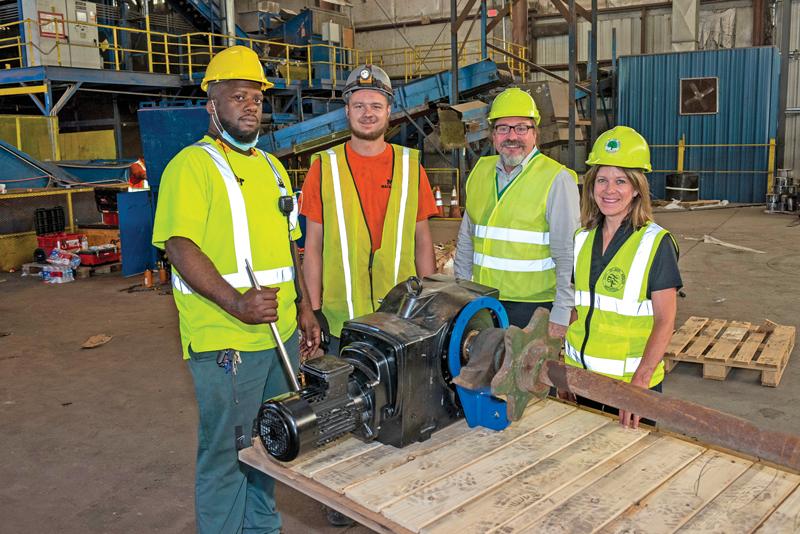When it opened in 1995, Ann Arbor’s Materials Recovery Facility put the city on the leading edge of the recycling movement. The mechanical and human sorters at the MRF (pronounced “murf”) made the paper, metal, glass, and plastics the city shipped out for sale cleaner and more valuable, and with commodity prices rising, it soon began returning money to the city’s solid waste fund. “If you don’t own your own landfill, the next best thing is to own your own MRF,” Mike Garfield, director of the Ecology Center, told the Observer in 2001. “Ann Arbor is one of the few success stories in the region when it comes to solid waste.”
The story seemed to get even better with the city’s move to “single-stream” recycling in the late 2000s. Reequipped to handle a more complex mix of materials and higher volumes, it drew business from as far away as Lansing and Toledo. According to the president of ReCommunity, the private company that operated it, from 2011 to 2015 the city’s share of the sales totaled almost $3 million.
Then the price of newspaper and glass plunged, and China stopped accepting many types of “foreign waste,” slashing demand for recyclable plastics. Meanwhile, reports of injuries at the MRF were raising red flags at the city.
“It was an operation safety matter that had to be addressed immediately,” then-city administrator Howard Lazarus told the Observer in 2016. “We don’t want anybody to get hurt, and we don’t want the taxpayers to be on the hook for a potential wrongful death or injury.”
That July, the city fired ReCommunity and closed the MRF. No one expected it would still be closed five years later.
—
Most of that time was spent debating what Lazarus called “the trade-off between community values and cost of operation.” Those priorities clashed immediately after Lazarus closed the MRF: the city’s interim solution was to hire Waste Management to compact recyclables and ship them to a MRF in Ohio.
Recycle Ann Arbor, the Ecology Center subsidiary that collects the city’s recyclables, pointed out that damaged the material. Council told Lazarus to instead hire RAA to haul the recyclables uncompacted. That cost more, but also set a pattern for decisions to come: the administrator would propose a way to consolidate services and save money, and council would instead tell him to work with RAA.
Recycling doesn’t appear to have been a factor in Lazarus’s surprise firing last year (“Chain of Command,” May 2020). But the following month, the city signed a ten-year contract with the recycling group to rebuild and reopen the MRF.
—
That’s why, last fall, Steve Pratt warned his wife and kids not to expect to see him for a year. As manager of the MRF, Pratt and his five-person staff faced a monumental task: clean the facility, install new state-of-the-art equipment, and prep it to start recycling again by August of this year.
That date has since slipped to October. “Nothing dramatic” caused the delay, says RAA director Bryan Ukena. “It took us a little bit longer because initially the city wanted to split the contract into processing and the lease agreement.” RAA argued for combining the two and eventually persuaded the city to do so.
The contract, Ukena says, is “very detailed and protects the city really well and protects RAA really well.” The nonprofit committed to spending $7.3 million to re-equip the facility, and the city committed to paying it $152 a ton to process its recyclables.
After cleaning out the building, a 3D laser measured everything to within a hundredth of an inch. What Ukena calls the “heavy work” of creating the final design drawings is now complete.
In mid-June, emails RAA spokesperson Bryan Weinert, a contractor was “on site to repair and refurbish the pieces of the existing equipment that will be reused in the new system. They are also marking all of the old equipment that will be removed. Additionally, they will help RAA identify any usable spare or replacement parts that can be salvaged. [The contractor] understands RAA’s mission is to reduce waste and they are working closely with us to make sure that we make the most use out of any equipment or parts that are still in good shape.”
Unfortunately, Weinert adds, most of the legacy equipment does not fall into either category. Ukena puts it more bluntly: ReCommunity pushed so much material through the facility that most is “too old and worn out” to put back in service.
—
RAA plans to start installing the new equipment at the end of the month. Ukena says the key upgrade is “optic sorting equipment. It’s really high-speed, high-resolution cameras and three-dimensional sensors and infrared optics.” Weinert emails that these can “detect and rapidly sort out the PET bottles (like soda or water bottles),” which are more easily reused, and more valuable, than unsorted “mixed plastics.”
Higher tech doesn’t mean fewer workers because the technology “still relies on people, but the optics just make it cleaner and more market-ready,” Ukena says. He figures they’ll have between twenty to twenty-two sorters and stresses “these are people that are really highly skilled in this type of work. They’re professionals, man.”
“As the number and type of materials to be recycled become more complex, the need for investment in equipment, sorting technology, and the number of sorters also becomes more complicated,” emails RAA communications director Erica Bertram. “Just like when we moved from two-stream recycling to single stream, the burden of sorting the material became more sophisticated and complex.”
The new jobs will all be union positions paying $17-$26 an hour, with benefits. “We’re looking to create a stable workforce that is here for years,” says Weinert. That’s what they’ve done with the folks driving the curbside pickup trucks. Their average driver has worked twelve years, and some have been with them twenty-eight years.
—
As always, two-thirds of Ann Arbor’s 14,200 annual tons of recyclables are paper products, these days mostly from packing material. “It’s called the Amazon effect,” Ukena explains, “because everybody’s getting stuff at their house now, and we see an uptick there. But by the same token, you see a major downtick in the commercial stream because the commercial businesses aren’t open.”
To recycle all that paper, RAA is working with Pratt Industries, a Georgia-based privately held producer of 100 percent recycled paper and packaging. “We connected with them a long time ago,” Ukena says. “They’ve got a new paper mill. It’s only 138 miles away [in Wapakoneta, Ohio]. And because it’s a new paper mill, they’re hungry for feedstock.”
Ukena reports that “HDPE natural (milk jugs) pricing has been higher than aluminum cans for over a year now, and the reason is due to supply and demand. Demand for HDPE natural has remained high due to its versatility and the fact that it is seen as universally recyclable, so brands want to keep using it.” That’s good news for the city, which gets 100 percent of the revenue from material sales–but since it’s only 1 percent of the local waste stream, it won’t balance the city’s structural deficit.
This summer’s broader recovery in commodity prices will help more. Asked by email if that will improve the MRF’s operating economics, Weinert had a one-word reply: “Yes!”
—
Ukena says the MRF can process 35,000 to 40,000 tons of recyclables annually “with a single shift. And we could put a second shift in.” This gives them lots of flexibility to process other communities’ recyclables. “The vision that we had from the very beginning [was] for this to be a regional facility,” says Ukena. “We’re out actively engaging in conversation with local communities and regional haulers.” He says they have “nothing to report yet, but we’re very hopeful and had a lot of interests coming from both sides.”
This ties into the current efforts toward regional recycling being handled by the Washtenaw Regional Resource Management Authority and the Western Washtenaw Recycling Authority.
After two years of delays by the former council majority, the new majority passed a resolution to join the WRRMA in February. Theo Eggermont, the county’s director of public works, emails that the group’s board is in favor of accepting the city, and “some members are in discussions with Ann Arbor to send their materials to the Ann Arbor MRF.”
WWRMA is “interested in creating a group contract for members who are interested to collectively send our materials there,” Eggermont adds. “If aggregated, the group has greater negotiating power and should expect to see a lower cost per ton.” He also notes that those tons should soon be much cleaner: a new “tagging and education grant … is expected to reduce contamination by 40% for WRRMA communities, starting June 21st.”
Eggermont estimates WRRMA’s collective annual volume at 8,010 tons. Even if all of it comes to the MRF, it would still have plenty of processing capacity. And more is better for everyone.
The city is currently paying RAA $147 a ton to ship its recyclables (uncrushed) to a MRF in Southfield. Once the MRF starts up, the city will be paying RAA $152 a ton.
That works out to more than $2 million a year, but the city will get credits tied to the current price of the materials produced. And as RAA lines up more contracts with other municipalities and haulers, the city will get a “host fee” of $13.50 per ton.
Even the worn-out equipment still has some value: Weinert emails that it “will be recycled since it is almost all steel.” Only some old conveyor belts will end up in a landfill.
Things are looking up for Steve Pratt, too. He emails that now he got “a site supervisor and additional support on site to help distribute my work load. My wife’s list of things to do around the house is getting shorter by the day.”
And though Ann Arborites who wheel their blue recycling carts to the curb each week won’t see any changes when the MRF restarts this fall, Ukena hopes “they’ll feel better about where their material goes–and what it gets made into.” To facilitate that feeling, they are “looking at rebuilding the education center” and are currently looking for grants and partnerships to fund that as well as plant tours to show schoolkids what will once again be a state-of-the-art recycling facility.





